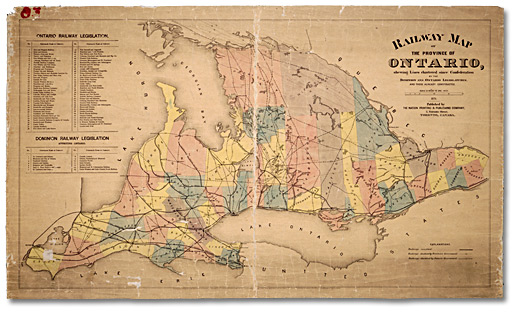
Table of Contents
Home | A Wilderness Paradise | Impact of Improved Transportation: Waterways
Impact of Improved Transportation: The Spread of the Railway
Impact of Improved Transportation: The Lure of the Wilderness
Impact of Improved Transportation: Cottages, Camps and City Parks
Government and the Tourism Industry: Growth of the Park System
Government and the Tourism Industry: Promotion and Infrastructure
Government and the Tourism Industry: Expansion and Diversification
|
Ontario's developing population, with more leisure time and wealth at its disposal, had an increased desire to escape the growing city centres. This became easier with the web of railway lines which opened up the hinterlands of southern Ontario to sports and outdoor enthusiasts, resort hotels, and early cottagers. The first railways were built in the 1850s to connect Montreal to Toronto and Ottawa to Prescott. Expansion was rapid and the railway map below shows the extent of completed railway routes in 1875 and charts the routes for planned railway systems. |
|
|
|
|
|
|
|
|
Routes and fares for trips to summer resorts were published in pamphlets that were widely available from ticket agents in urban centres. |
|
|
|
|
|
|
Steamship lines and railroads coordinated their schedules so that passengers could move easily from train station to pier. The poster below, from 1896, advertises a new route to the Muskoka Lakes and Georgian Bay that used a combination of rail and stagecoach.
|
|
|
|
|
Large and imposing railway stations such as this one, at Front and Yonge streets in Toronto, for the Great Western Railway were built in the main cities to handle the traffic. By 1890 nearly every town had a station for freight and passengers.
Click to see a larger image (96K)
|

|
|
|
|
|
|
|
|
|
|
|
Many took the train to Bala on Lake Muskoka and transferred to a steamship to get to the resorts and cottages on the lakes.
Click to see a larger image (77K)
|
 |
|
|
|
A Wilderness Paradise | Impact of Improved Transportation: Waterways
Impact of Improved Transportation: The Spread of the Railway
Impact of Improved Transportation: The Lure of the Wilderness
Impact of Improved Transportation: Cottages, Camps and City Parks
Government and the Tourism Industry: Growth of the Park System
Government and the Tourism Industry: Promotion and Infrastructure
Government and the Tourism Industry: Expansion and Diversification





![Plan of the front elevation of a freight and passenger station for the Simcoe Great Western Railway Glencoe and Fort Erie Loop Line, [1870]](pics/26638_train_depot_520.jpg)
![Photo: Niagara Falls - aerial view of train station, [191-]](pics/21284_nigara_station_520.jpg)
